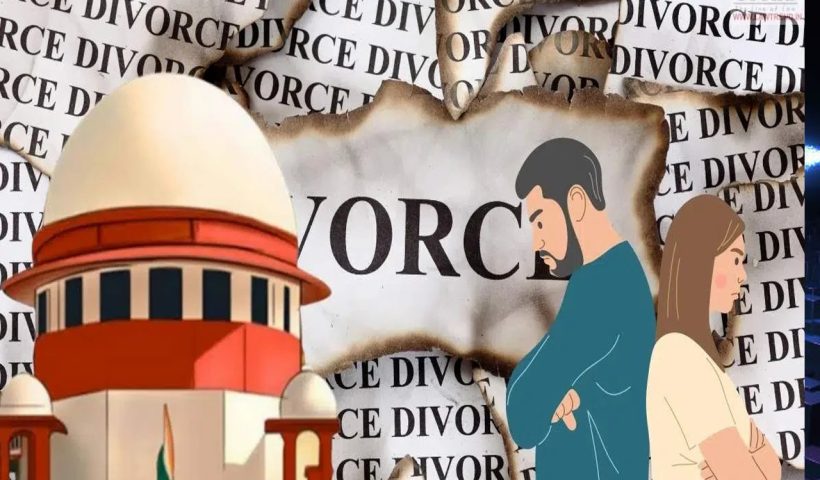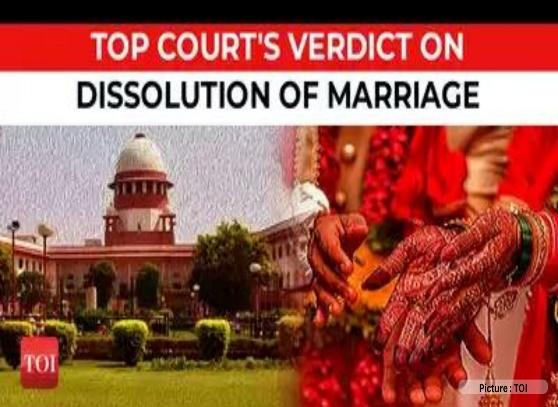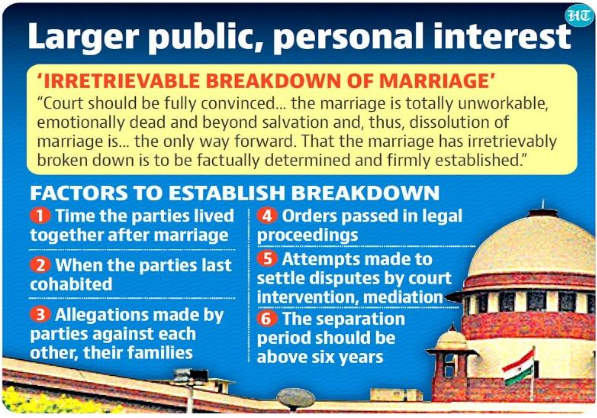- Courses
- GS Full Course 1 Year
- GS Full Course 2 Year
- GS Full Course 3 Year
- GS Full Course Till Selection
- MEP (Mains Enrichment Programme) Data, Facts
- Essay Target – 150+ Marks
- Online Program
- GS Recorded Course
- NCERT- First Ladder
- Polity
- Geography
- Economy
- Ancient, Medieval and Art & Culture AMAC
- Modern India, Post Independence & World History
- Environment
- Governance
- Science & Technology
- International Relations and Internal Security
- Disaster Management
- Ethics
- Current Affairs
- Indian Society and Social Issue
- CSAT
- 5 LAYERED ARJUNA Mentorship
- Public Administration Optional
- ABOUT US
- OUR TOPPERS
- TEST SERIES
- FREE STUDY MATERIAL
- VIDEOS
- CONTACT US
Supreme Court Allows Divorce on Irretrievable Breakdown
Supreme Court Allows Divorce on Irretrievable Breakdown


Latest Context 
Recently, the Supreme Court (SC), under the power granted via Article 142(1) of the Indian Constitution to do ‘complete justice’ ruled that it can dissolve a marriage on the ground that it had broken down irretrievably without referring the parties to a family court where they must wait 6-18 months for a decree of divorce by mutual consent.
Article 142 (1) of the Constitution
- Article 142 (1): Article 142(1) confers sweeping power on the Supreme Court to pass such decree or make such order as is necessary for doing ‘complete justice’ in any cause or matter. Furthermore, it must be “based on considerations of fundamental general and specific public policy”.
- Meaning of Fundamental General Conditions of Public Policy: It refers to the fundamental rights, secularism, federalism, and other basic features of the Constitution. Specific public, as defined by the court, means “some express pre-eminent prohibition in any substantive law, and not stipulations and requirements to a particular statutory scheme”.
Supreme Court Ruling
- Judgement: The SC has ruled in the case of Shilpa Sailesh vs. Varun Sreenivasan (2023) that it has the power to dissolve a marriage if it is irretrievably broken down. Further, the court stated that it can waive the mandatory six-month waiting period for divorce under the Hindu Marriage Act (HMA), 1955, and allow the dissolution of the marriage on grounds of an irretrievable breakdown even if one of the parties was not willing.
Conditions (see image)

Implications of the Ruling:
- Correct Explanation of the Judgement: It does not imply that people can go straight to the SC for a quick divorce. Moreover, it is “not a matter of right, rather a discretion which needs to be exercised with great care and caution”. The Supreme Court also clarified that a writ petition under Article 32 (or Article 226) of the Constitution of India to seek relief of dissolution of marriage on the ground of irretrievable breakdown of marriage directly from it cannot be filed by the party.
- Necessity to Shift away from Fault Theory: SC highlighted the need to move away from “fault theory” and “accusatorial principle of divorce” under Section 13 (1) of HMA 1955, which prescribes divorce on grounds where one of the spouses can be held guilty of some misdeeds like cruelty, adultery or desertion.
- Limitations of the Hindu Marriage and Special Marriage Act: Both acts are premised on the ‘fault’ or ‘matrimonial offense’ theory for the purpose of divorce. HMA permits the innocent party to have a divorce if the other party has committed a matrimonial offense. Under HMA 1955, there are seven fault grounds for divorce: insanity, leprosy, venereal disease, and sannyasa adultery, cruelty, desertion, and conversion, Additionally, there are four grounds on which the wife can sue alone: non-resumption of cohabitation after maintenance order, and decree for maintenance, rape, sodomy, bestiality. The innocent party must prove that they are blameless for the divorce to be granted under this theory.
Significance of the Ruling:
- Simplification of the Procedure: It will simplify the legal process of divorce. It is a time-consuming and lengthy process due to the large number of similar cases pending before family courts. This judgment permits parties to bypass the waiting period and directly approach the Supreme Court for a divorce on grounds of irretrievable breakdown. According to the Supreme Court, if no possibility of reconciliation exists, it would be meaningless to prolong the mental suffering of the parties in a marriage.
- Speedy Solution: Even if one of the parties in the marriage agrees, dissolution of marriage would provide a speedy solution for the parties who are unable to live together and have mutually agreed that the marriage should be dissolved.
- New Ground: This judgment is significant because it provides a new ground that is an “irretrievable breakdown “of the marriage that was not yet a ground for divorce under the Hindu Marriage Act (HMA) 1955. Still, there
is no codified law for the irretrievable breakdown of marriage till date. Though, the HMA 1955 recognizes a few grounds for dissolution of marriage under Section 13.
Other Judgements Related to Divorce
- Amit Kumar vs Suman Beniwal (2021): The SC stated “Where there is a chance of reconciliation, however slight, the cooling period of six months from the date of filing of the divorce petition should be enforced. In case, if reconciliation is not possible, it would be meaningless to prolong the agony of the parties to the marriage.”
- Bhagwat Pitambar Borse vs. Anusayabai Bhagwat Borse (2018): The Bombay HC held that desertion by the wife for more than seven years without any reasonable cause and without any intention to return is a valid ground for divorce.
- Further Proceedings: A two-judge bench referred this matter regarding the court’s exercise of powers under Article 142 to grant a divorce without sending the parties to a family court to the larger bench of 5 judges in June 2016.
- Due to contradictory views of the different benches of the top court, it also sought clarity on the broad parameters for the exercise of powers under Article 142 to dissolve a marriage between the consenting parties. As a result, the smaller bench had appointed senior advocates Indira Jaising, Dushyant Dave, V Giri, and Meenakshi Arora as amici curiae (friends of the court) to assist the Constitution bench in June 2016.
Law Commission Recommendation on Irretrievable Breakdown
- Introduction of the Concept: The Law Commission in its 71st report (1978), dealt with the concept of irretrievable breakdown of marriage. It recommended irretrievable breakdown as an additional ground of divorce in its report in 1978 and 2009. As far back as 1920, New Zealand was the first Commonwealth country to introduce the provision that a three-year or more separation agreement could be a ground for filing a petition in the courts for divorce.
Hindu Marriage Act,1955
- Conceptual Framework: It is an act of the Parliament of India. It amends and codifies the law relating to marriage among Hindus and others. It is applicable to Hindus, Buddhists, Jains, Sikhs, and anyone but not a Muslim, Christian, Parsi, or Jew by religion.
- Procedure for Divorce under HMA: The HMA provides “divorce by mutual consent” under Section 13B which states that both parties in marriage must together file a petition in the district court. Due to being unable to live together, It will be done on the grounds that they have been living separately for a period of one year or more. They have mutually agreed that the marriage should be dissolved.
- Filing the Second Petition: Parties must move a second motion before the court at least 6 months after the date of the presentation of the first petition and not later than 18 months after the said date (provided, the petition is not withdrawn in the meantime). The mandatory six-month wait is intended to give the parties time to withdraw their plea. A petition for divorce by mutual consent can be moved only after a year of the marriage.
- Section 14 of HMA: In case of “exceptional hardship to the petitioner or of exceptional depravity on the part of the respondent” section 14 of HMA allows a divorce petition very soon. Under Section 13 B (2), a waiver of the six-month waiting period can be sought in an exemption application filed before the family court.
Status of Marriage Equality in India
- Divorce Rate and Trends in India: A survey based on 160,000 households was conducted in 2018. It revealed that 93% of Indians had ‘an arranged marriage’ which is against the global average of about 55%. India has a low annual divorce rate of 1.1 % per 1,000 people with only 13 out of every 1,000 marriages resulting in divorce. More importantly, men are usually the initiators.
- Gender Inequality: Social norms and societal traditions discourage women from seeking a divorce. If they do, they face legal hassles and socio-economic isolation especially in the case when they are financially dependent on their spouses.
Women’s Economic Dependency:
- Low Participation: Low rate of labor-force participation of Indian women is the main reason for financial dependency that forces them to ‘adjust’ to bad marriages.
- Socio-Economic Challenges of Women after Divorce: The dissolution of a marriage affects women in many ways such as chronic strains of divorce, lower chances of re-partnering, disproportionate losses in household income, higher risk of losing homeownership, and greater responsibilities of single parenting.

Prelims:
Q. With reference to the Constitution of India, prohibitions or limitations or provisions contained in ordinary laws cannot act as prohibitions or limitations on constitutional powers under Article 142. It could mean which one of the following? (2019)
(a) The decisions taken by the Election Commission of India while discharging its duties cannot be challenged in any court of law.
(b) The Supreme Court of India is not constrained in the exercise of its powers by laws made by the Parliament.
(c) In the event of a grave financial crisis in the country, the President of India can declare Financial Emergency without the counsel from the Cabinet.
(d) State Legislatures cannot make laws on certain matters without the concurrence of Union Legislature.
Ans: (b)



